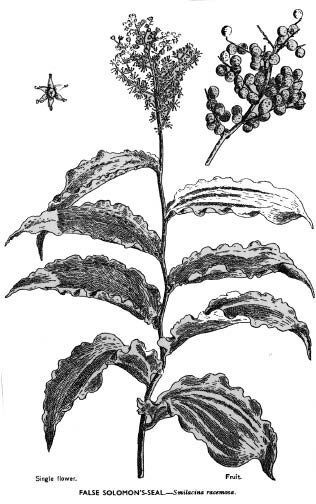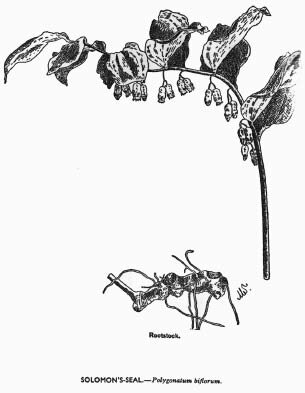
Discover rewarding casino experiences. 

Please Don't Quote Me Mother Nature’s clock is accurately ticking, however, with the correct times being spelled out in wildflowers emerging. Wild Phlox are flocking. Spring beauties have sprung. Rue Anemone rue the cold mornings. Wildflowers go by their strict time clock. |
Perhaps it’s their underground rhizome (rootstock) that causes their names to be alike one being False Solomon’s seal and the other merely Solomon’s seal (great or small to the purists). There are four varieties of Solomon’s seal in North America. The plant is found throughout Europe, the Asian continent all the way to Japan. They prefer moist to dry conditions and like a forest glade or shady bed. Yellow-greenish bell-like flowers droop for each leaf axil of the true Solomon’s a single or as many as ten flowers may dangle from the thin stem from the leaf axil. The graceful frond sways in the summer zephyr, the six-petalled flower delicately making one wish some teeny-tiny bell sound would tinkle to enrapture us!
It may have been the six petal outline that gave the plant its name. Each year the plant sends up one of its above ground stems from the root. The age of the plant may be read in the root because the previous year’s stem has made a scar on the rhizome. Each scar reminded someone in centuries past of the sealing wax important people used to drip onto documents or envelopes, then press their signet ring into the hot wax to seal it so as to be opened only by the addressee who would know who it was from by the design of the signet. Solomon’s seal was among the most important, thus the name. His design was a six-pointed logo (like the flower petal) that actually was two triangles superimposed over one another. ‘Way back the Seal of Solomon was known as the Star of David that we recognize today. One triangle represented the body while the other meant the soul, here reproduced. One legend was that Solomon’s finger ring had a mirror in the center in which he could see people and events at distances, far and away. Later it evolved into the two triangles and the pretty story carried on with the wildflower. Another less dramatic story rises in its species name plygonum from the Greek meaning, poly-many and gonu, knees indicating the several joints or bends in the roots stock. Even another legend was that the Solomon’s Seal actually sealed up cuts and stopped bleeding ... It sealed, healed wounds and broken bones. By 1597 the author of The Herbalist, John Gerard, quoted a Greek philosopher, Dioscorides, to that effect in its fixing bones and was a balm. Before Lineaus’ botanical system was set, out the name Sigillim salmonis referred to the sealing and healing of wounds ... Salmonis meaning salve which was eventually corrupted to Solomon. Some herbalists in ancient days believed that Solomon, along with other awesome personality traits was a magician who could perform acts of healing, blood stopping so thus invoked his name on the plant. Uses of the Solomon’s Seal, both kinds, by the Native American were innumerable just as it had been since Solomon’s time. Talk about the universal mind! Chippewas used Solomon’s Seal to cure headaches. By preparing the rhizome in a decoration, sprinkling it on hot stones with the smoke being inhaled.
Some tribes utilized the rootstock for women’s complaints and internal pain. Penobscot Indians treated gonorrhea with a mixture of Solomon’s Seal and other herbs to aid in kidney disorders and the spitting up of blood. Rhizomes boiled in milk treated hemorrhoids and was used as a laxative which the pioneers had adopted for poison ivy and skin irritations also. The Mesquakie called the False Solomon Seal peshnekikiemini or “udder berries” because the animal loved the purple-speckled red berries which they themselves burned to smudge for crying babies. And return people to normalcy from temporary insanity! Eaten during plagues, it could have prevented illness. “False” loosened the bowels in certain recipes while others cast spells. False Solomon’s Seal differs from the true by sprays of tiny, starry white blossoms growing at the very end of the tall stalk where, too, of course, the berries develop. The illustrations here show the differences in flower/berry characteristics. They are taken from How to Know the Wildflowers by Mrs. William Starr Dana and illustrated by Marion Satterlee, published in 1893. Text and drawings are so interesting; illustrations excellent. While the False Solomon’s Seal grows only in North America, both it and the true are related to the lily family.
Both and all varieties were used in innumerable ways in past centuries. Monominees used the boiled liquid of the False to steam away catarrh. Flambeau/Ojibway mixed with the False with dogbane to keep the kidneys open during a woman’s pregnancy and to cure throat ailments, headaches or as a “reviver.” They were to strengthen heart contractions, increase blood pressure, rate of digestion slowed the pulse and treated dropsy, among other condition. It could be eaten early in the spring like asparagus but the berries contain anthraquinone causing diarrhea and vomiting so don’t try any of it in any culinary or pharmacopoeia experiment even if Emeril or Bobby Flay suggests it. Just try to remember the difference between false and true Solomon’s Seal and their May-June appearance in the Northwest of Illinois.
|






